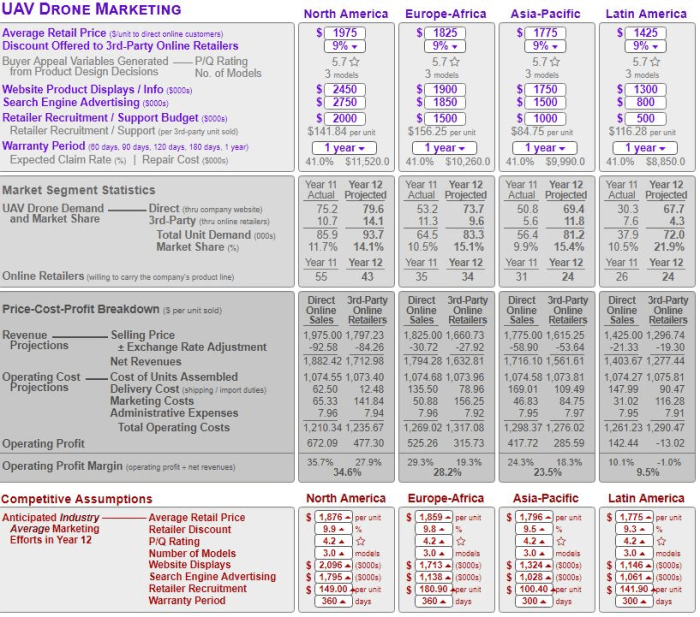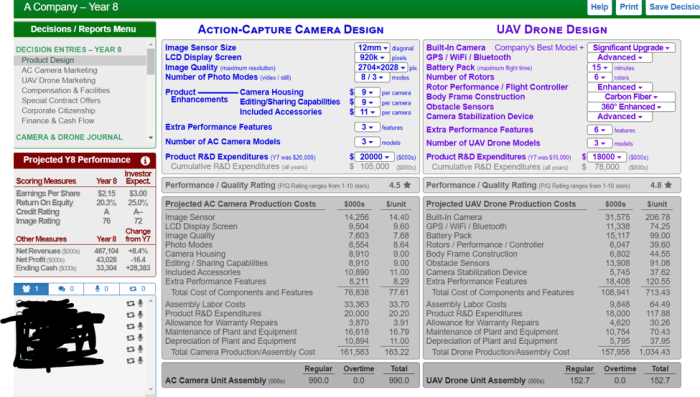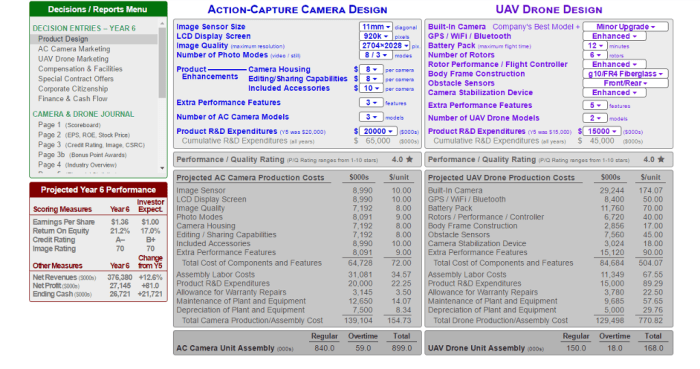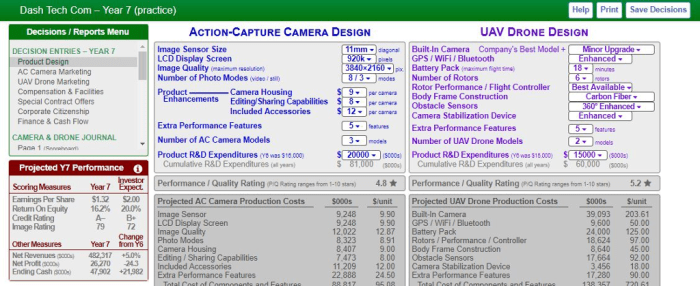Welcome to the definitive guide to Glo-Bus Year 7 Decisions Answers. This comprehensive resource provides an in-depth exploration of the critical decisions and strategies required to excel in this pivotal phase of the simulation. With a focus on strategic planning, marketing, operations, finance, team dynamics, and communication, this guide empowers teams to make informed choices that drive exceptional performance.
As you navigate the complexities of Glo-Bus Year 7, this guide serves as an invaluable companion, offering expert insights and practical guidance. Embrace the knowledge and strategies presented within these pages to unlock your team’s full potential and emerge victorious in the competitive global marketplace.
Overview of Glo-Bus Year 7 Decisions
Glo-Bus Year 7 decisions mark a crucial phase in the simulation, where teams navigate complex market dynamics and make strategic choices to drive growth and profitability.
This phase presents both challenges and opportunities, requiring teams to adapt to evolving market conditions, optimize operations, and seize opportunities for expansion.
Key Challenges
- Intensified competition from both domestic and international rivals
- Rising production costs and supply chain disruptions
- Fluctuating demand and consumer preferences
- Technological advancements and market disruption
Key Opportunities
- Expansion into new markets and customer segments
- Product innovation and differentiation
- Strategic alliances and partnerships
- Cost optimization and operational efficiency
Strategic Planning and Decision-Making

Strategic planning in Glo-Bus Year 7 involves a systematic approach to defining a company’s long-term goals and objectives, and developing strategies to achieve them. This process includes conducting market research, analyzing competitors, and forecasting financial performance.
Market research provides insights into customer needs, preferences, and market trends. Competitive analysis helps identify strengths and weaknesses of competitors, and financial forecasting predicts future financial performance based on historical data and assumptions about future events.
Market Research
Market research is essential for understanding the target market and identifying opportunities for growth. Teams should conduct surveys, focus groups, and interviews to gather data on customer demographics, needs, and preferences. This information can be used to develop marketing campaigns, product development strategies, and pricing strategies.
Competitive Analysis
Competitive analysis helps teams identify the strengths and weaknesses of their competitors. This information can be used to develop strategies to differentiate products and services, and to target specific customer segments. Teams should analyze competitor pricing, marketing strategies, and product offerings.
Financial Forecasting
Financial forecasting helps teams predict future financial performance. This information can be used to make decisions about investments, production levels, and pricing. Teams should use historical financial data and assumptions about future events to develop financial forecasts.
Examples of Successful Strategic Decisions
- One team in a previous Glo-Bus simulation conducted extensive market research and identified a niche market for a new product. The team developed a marketing campaign targeted at this niche market and was able to achieve significant market share.
- Another team in a previous Glo-Bus simulation conducted a competitive analysis and identified a weakness in a competitor’s product. The team developed a product that addressed this weakness and was able to gain market share from the competitor.
- A third team in a previous Glo-Bus simulation conducted financial forecasting and identified an opportunity to reduce costs by outsourcing production. The team implemented this strategy and was able to improve profitability.
Marketing and Sales Strategies

Effective marketing and sales strategies are crucial for Glo-Bus Year 7. These strategies should align with the company’s overall objectives, target market, and competitive landscape.
Pricing Strategies, Glo-bus year 7 decisions answers
Pricing strategies play a vital role in determining product demand, revenue generation, and profitability. Different pricing strategies have varying impacts on these factors.
| Pricing Strategy | Impact |
|---|---|
| Cost-Plus Pricing | Based on production costs plus a markup for profit, ensuring a stable profit margin but potentially limiting market share. |
| Value Pricing | Sets prices based on the perceived value of the product to customers, focusing on customer satisfaction and building brand loyalty. |
| Competitive Pricing | Matches or slightly undercuts competitor prices, effective in gaining market share but may result in lower profit margins. |
| Premium Pricing | Sets prices above competitors, targeting customers who value exclusivity and high quality, leading to higher profit margins but potentially limiting sales volume. |
Marketing Channels
Choosing the appropriate marketing channels is essential for reaching the target market and achieving marketing objectives. Each channel offers unique advantages and disadvantages.
- Online Marketing:Includes search engine optimization (), social media marketing, email marketing, and online advertising. Advantages include global reach, cost-effectiveness, and targeted advertising. Disadvantages include competition and the need for ongoing optimization.
- Offline Marketing:Encompasses print advertising, television commercials, billboards, and trade shows. Advantages include high impact and brand visibility. Disadvantages include high costs and limited targeting capabilities.
- Public Relations:Involves building relationships with media outlets to generate positive publicity. Advantages include credibility and increased brand awareness. Disadvantages include lack of direct control over messaging and potential negative coverage.
- Sales Promotion:Includes discounts, coupons, and loyalty programs. Advantages include stimulating immediate sales and building customer loyalty. Disadvantages include reducing profit margins and potentially damaging brand image.
Production and Operations Management

Production and operations management involves planning, organizing, and controlling the activities necessary to produce goods and services. In Glo-Bus Year 7, optimizing production processes and reducing costs are crucial for business success.
Principles of Production and Operations Management
- Efficiency:Maximizing output while minimizing input resources.
- Effectiveness:Achieving desired outcomes that align with business objectives.
- Quality:Producing goods and services that meet customer expectations.
- Flexibility:Adapting to changes in demand, technology, and market conditions.
- Integration:Coordinating production and operations with other business functions.
Optimizing Production Processes and Reducing Costs
- Analyze production processes:Identify bottlenecks, inefficiencies, and waste.
- Implement lean manufacturing principles:Eliminate non-value-added activities and streamline processes.
- Automate tasks:Use technology to reduce labor costs and improve efficiency.
- Negotiate with suppliers:Secure favorable terms for raw materials and components.
- Optimize inventory levels:Balance the costs of holding inventory with the risks of stockouts.
Inventory Management Techniques
| Technique | Application |
|---|---|
| First-In, First-Out (FIFO) | Ensures older inventory is sold first, reducing the risk of spoilage or obsolescence. |
| Last-In, First-Out (LIFO) | Assumes newer inventory is sold first, potentially reducing taxes by valuing inventory at lower historical costs. |
| Weighted Average Cost | Calculates an average cost for inventory based on the cost of all units purchased, regardless of when they were acquired. |
| Just-in-Time (JIT) | Minimizes inventory by receiving materials and components only when needed, reducing storage costs. |
Financial Management and Control: Glo-bus Year 7 Decisions Answers

Financial management and control are critical to the success of any business, and Glo-Bus Year 7 is no exception. By effectively managing your finances, you can ensure that your company has the resources it needs to grow and prosper.There are a number of best practices that you can follow to improve your financial management and control.
These include:
Budgeting
Creating a budget is the first step to effective financial management. A budget will help you to track your income and expenses, and ensure that you are living within your means. When creating a budget, be sure to include all of your income and expenses, both fixed and variable.
Cash Flow Management
Cash flow management is essential to ensuring that your company has the cash it needs to meet its obligations. To effectively manage your cash flow, you need to track your cash inflows and outflows, and forecast your future cash needs.
Financial Reporting
Financial reporting is the process of providing information about your company’s financial performance to investors, creditors, and other stakeholders. Financial reporting can help you to attract investors, secure loans, and build relationships with customers and suppliers.
Financial Ratios
Financial ratios are a powerful tool for assessing your company’s financial performance. By comparing your company’s financial ratios to industry benchmarks, you can identify areas where you need to improve.
Team Dynamics and Communication
Effective team dynamics and communication are crucial for success in Glo-Bus Year 7. A cohesive team with open and transparent communication can make better decisions, solve problems more efficiently, and achieve higher levels of performance.To build a cohesive team, it is important to establish clear roles and responsibilities, encourage active listening, and foster a culture of respect and trust.
Team members should be open to sharing ideas and perspectives, even if they differ from their own.
Resolving Conflicts and Making Decisions
Conflicts are inevitable in any team environment. The key is to resolve them constructively. When conflicts arise, team members should focus on understanding the underlying issues, rather than attacking each other. Active listening and empathy can help build bridges and find common ground.When
making decisions, it is important to involve all team members in the process. This ensures that everyone has a voice and that decisions are made with the input of all perspectives. Majority rule can be used to make final decisions, but it is important to consider minority opinions and ensure that everyone feels heard.
FAQ Section
What is the primary objective of Glo-Bus Year 7?
The primary objective of Glo-Bus Year 7 is to make strategic decisions that maximize the company’s performance in a simulated global business environment.
How can teams effectively conduct market research in Glo-Bus Year 7?
Teams can conduct effective market research by analyzing industry reports, conducting surveys, and monitoring competitor activity to gain insights into market trends, customer preferences, and competitive dynamics.
What are some key financial ratios that teams should monitor in Glo-Bus Year 7?
Key financial ratios to monitor include profitability ratios (e.g., gross profit margin, net profit margin), liquidity ratios (e.g., current ratio, quick ratio), and solvency ratios (e.g., debt-to-equity ratio, interest coverage ratio).
How can teams foster effective communication and collaboration in Glo-Bus Year 7?
Teams can foster effective communication and collaboration by establishing clear communication channels, holding regular team meetings, and using collaborative tools to share information and facilitate decision-making.